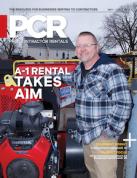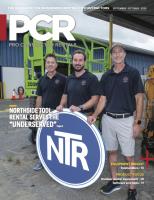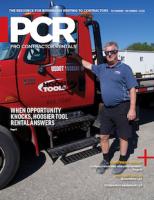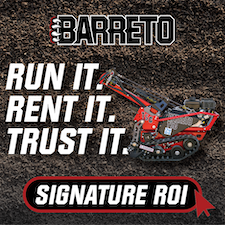Industry Outlook -- Next-generation equipment power
Simpler. Safer. Low maintenance. Li-ion and other power sources are making headway into the world of the internal combustion engine.
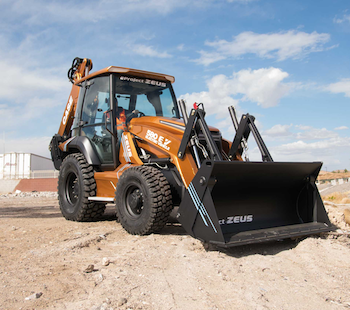 |
|
Case Construction Equipment introduced the 580EV all-electric backhoe loader at ConExpo that offers the same performance as diesel-powered units, sources report. |
With tighter engine emissions requirements on the horizon, OEMs are working hard to develop equipment that provides the power that end users have come to expect from engine-powered units. Industry experts share how these alternative power sources are changing the world of all sizes of tools and equipment and how they can fit into the rental fleets of today and tomorrow.
More power, smaller size
 |
| Dave Schulenberg Briggs & Stratton product manager, alternative power |
There are two major trends in Li-ion power development: more power and energy in a smaller package and overall lower cost. The automotive industry is rapidly accelerating Li-ion battery cell technology and the benefits from that development filter down into other industries because equipment manufacturers use many of the same cells. Smaller package sizes and lower-cost cells are allowing us to develop complete battery solutions for applications that weren’t feasible as recent as 12 months ago.
Li-ion brings a real no-maintenance option as a power source, but many people don’t understand that. People often confuse the Li-ion battery technology with other types of batteries like lead acid and absorbent glass mat (AGM). Those older technologies may require maintenance, like adding water, and don’t perform nearly as well as Li-ion. It’s important to educate service personnel and end users so they understand the advantages of Li-ion technology so they can steer end users to using Li-ion-equipped products because of those advantages.
Rental customers need to be prepared for the charging requirements of products with large Li-ion batteries. Unfortunately, 110-volt current is limited in terms of how much charging power it can provide. Therefore, rental customers need to understand what charge times they might get from the typical 110-volt outlet or look for an option that uses a 220-volt circuit. Rental centers can help educate the customers on expected charging times, which helps customers maximize their uptime and productivity.
Charging technology helps manage systems
The global construction market is expected to increase rapidly over the next several years. In 2019, the market size was US$129.32 billion and is projected to reach US$160.84 billion by 2027.
 |
|
Rod Dayrit, Delta Q director of business development |
There are three drivers toward equipment electrification. First, improvements in lithium battery technology are bringing the total cost of ownership for electric models lower than diesel-powered models. Li-ion batteries do not require watering and are three times smaller and four times lighter than lead-acid batteries and are faster and more efficient to charge. Li-ion batteries deliver more than a 2,000 charge-cycle life, likely to last as long as the machine in which they are installed.
Second, electric equipment is less complicated than traditional engine-powered equipment. Electric vehicles have better torque at low speeds without complex transmission gears and fluids. Less complexity means greater design flexibility and lower cost. With a shorter product planning cycle for electric equipment, companies can design more machines in a shorter period.
Third, telematics and automation can enhance electric batteries and gather data to improve battery life and equipment performance. The machine collects a wide range of information and can alert the user of a potential issue before it occurs, which reduces repair and labor costs. Smart battery chargers, such as Delta-Q chargers, track charging data and use consistency that will helps inform and improve future use and purchase decisions.
While OEMs are beginning to release fully electric versions of compact construction equipment, another alternative to gas- or diesel-powered equipment are hybrid electric vehicles. These machines use an internal combustion engine (ICE) and an electric motor to obtain maximum power and fuel economy with minimum emissions. They are an option for higher power applications that cannot exclusively rely on electric solutions because of high peak power demands or long operating times between charges.
Another option are range extenders that expand the vehicle’s range when the batteries are depleted. Range extenders are similar to hybrid vehicles except the ICE does not drive the vehicle, it only produces power for the electric or battery system.
Electric drives work
There has been increasing jobsite demand for engine-powered products that can deliver fewer or no emissions. Manufacturers have been responding with Tier 4 Final-compliant diesel engines and hybrid products such as the Genie Z-60 FE MEWP, which can offer quiet, emissions-free operation.
 |
|
Mike Flanagan, Terex AWP Genie product manager |
Genie has been long involved in developing alternative power that boosts job site productivity and efficiency for end users while also offering high ROI and low cost of ownership for rental center customers. The recently launched Genie E-Drive electric drive, now available across Genie’s GS slab scissor family, is a great example of this. With a fully-sealed, AC electric drive system, Genie E-Drive slab scissors offer 30 percent more runtime per charge than traditional hydraulic drive designs. Plus, they have 70 percent fewer hydraulic hoses and fittings than a hydraulically driven slab scissor, significantly reducing the risk of hydraulic leaks.
Electric drive systems historically were challenged by tough job site conditions. However, thanks to advances in technology, many of those barriers have been eliminated, increasing the utility of electric drive machines on many job sites. The E-Drive slab scissor lifts are designed to perform in real-world conditions, using similar motors to the all-terrain Genie Z-60 FE hybrid electric boom.
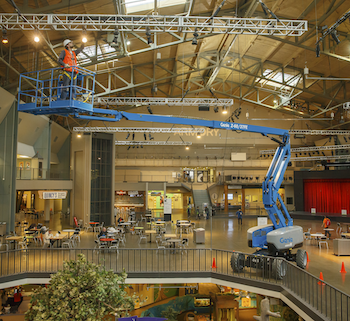 |
| Manufacturers have been responding with Tier 4 Final-compliant diesel engines and hybrid products such as the Genie Z-60 FE MEWP that can offer quiet, emission-free operation. |
When rental centers are evaluating fleet options, including models that use next-generation power, an important consideration is their customers’ job site needs. Even though electric drive machines can effectively deliver the performance required for many of jobs, there also are jobs where a hybrid solution makes even more sense, while on other job sites, it might be a few years before full electrification will be the best choice. As a result, rental centers benefit by optimizing their fleets to match the equipment to their customers’ jobs.
Genie is focused on innovating the ways it can deliver job site productivity, efficiency and reliability that can increase uptime and deliver high ROI for rental customers. Rental centers can better plan for maintenance by utilizing telematics data, like that provided by Genie LiftConnect telematics. This helps rental centers ensure equipment is ready to rent when their customers want it.
On the demand side, power, productivity and efficiency combined with job site versatility can add value for hybrid machines. Because they can work indoors or outdoors, eco-friendly Genie hybrid Z-boom lifts deliver productivity in a machine that is often the first on and the last off of job sites.
Genie engineers worked hard to assure electric-drive system reliability. They worked closely with suppliers to develop a fully-sealed, AC electric drive system that can withstand real-world conditions and is not susceptible to damage from job site debris or moisture.
Electric equipment stigma changing
There has been a stigma associated with battery-powered equipment but is changing with improved battery technology and the rising popularity of performance electric vehicles
 |
|
Jeremy Rupp, Granite Industries marketing director |
from Tesla and Porsche. The interest in electric power in the general public has filtered down to battery powered equipment. Li-ion battery technology continually improves and the prices are dropping faster than expected.
While many applications use Li-ion technology without issue, there are still many larger equipment applications that require deep-cycle sealed lead-acid (SLA) batteries. SLA battery technology has improved, thanks to the development of absorbent glass mat (AGM) batteries, which increase performance and battery life. The latest battery technologies have provided a way for manufacturers to meet and exceed customer demands.
Low maintenance leads the list of reasons why rental centers should consider next-generation equipment in their fleets. As long as the unit is charged, no other routine maintenance needs to be completed between rentals. Almost all battery-powered drive systems are sealed for life, which means they never need oil or air filter changes or belt replacements.
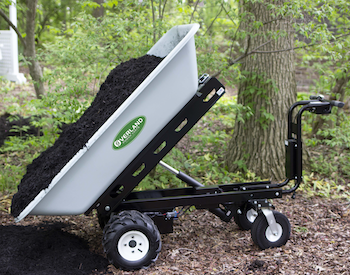 |
| Battery-powered equipment is traditionally extremely user friendly. Due to zero emissions and zero noise, battery-powered units can be used early in the morning as well as indoors |
Battery-powered equipment is traditionally extremely user friendly. Due to zero emissions and zero noise, battery-powered units can be used early in the morning as well as indoors. One downside to next-generation powered equipment is there may be a larger investment every 3 to 5 years if the batteries need to be replaced.
Rental centers can increase demand by promoting the many benefits of next-generation powered tools and equipment. When a customer hears the benefits of battery-powered equipment for their rental job, it can help to dispel the past stigma about battery-powered equipment. Improved ROI can be found with the lower maintenance costs and also by reaching a wider range of customers.
Battery life is the most common concern for customers renting or purchasing battery-powered equipment. There is a fear that if the unit runs out of battery charge, they will be left with a job unfinished. There are two ways to reduce that fear: First, make sure the battery-powered equipment has been thoroughly tested in real-world applications. Second, send out a backup battery pack, either included with the rental or offered as a small upcharge. While this increases the rental location’s initial cost when purchasing the units, it can provide the customer and the rental shop peace of mind the rental will last through the entire day.
Li-ion power looks promising
Like many manufacturers, Hy-Brid Lifts is considering switching to a Li-ion battery. The benefits are undeniable – longer run time, quicker charging, less maintenance and lifelong batteries. The tradeoff, however, is an increase in upfront cost for rental centers.
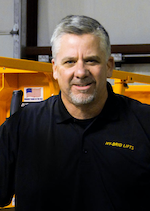 |
| Terry Dolan, Hy-Brid Lifts president and CEO |
Some Hy-Brid lifts come standard with AGM batteries or offer them as an option. By using AGM batteries in these lifts, customers realize maintenance-free batteries and increased runtime. Unlike wet-cell batteries, AGM batteries do not require consistent maintenance and additional water. This comes into play when a machine rents out for an extended period of time – three or four months – and the customer is expected to keep up with the battery maintenance. If the lift has a wet-cell battery and the rental customer doesn’t properly keep up with it, the battery will prematurely die. With an AGM battery, the hassle of battery maintenance won’t fall on the customer.
Li-ion power has been developing rapidly, and we look forward to the continued research and development that makes it a more attainable and affordable alternative for the MEWP industry. Replacing batteries less frequently saves time, money and holds an environmental impact as well.
Lower operating costs with electric power
As construction and agricultural machine manufacturers look for solutions regarding the zero emissions movement, more electrical-powered machinery will enter the market. Most
 |
| Ethan Clowes, JCB North America backhoe loader, wheel loader and Site Dumper product manager |
are prototypes, but JCB recently launched a full range of electric-powered machines with zero emissions. These innovative machines are a viable solution for today’s problems, eliminating emissions that negatively affect our health and the environment.
Additionally, reduced running costs, low maintenance and low noise provide better performance than current machines on the market, particularly for customers who have noise- or emissions-sensitive sites. Every application can benefit from E-Tech technology, however, maintenance costs and downtime are greatly reduced, increasing productivity and profitability.
JCB recently introduced the JCB 505-20E, an electric version of its popular Loadall. This machine is designed to deliver the same performance as the conventional diesel-powered machine but offers a zero-emissions material handling solution. It uses two electric motors, one for the driveline and the second to power the hydraulic system. The 23 horsepower motor drives the permanent four-wheel drive drop box to JCB drive/steer axles. The 30 horsepower hydraulic system motor powers a fixed displacement gear pump, delivering a maximum 21 gpm of flow. Flow is proportional to joystick position and the lift end is controlled by an electro-hydraulic valve block, with hydraulic regeneration on boom lower and retract.
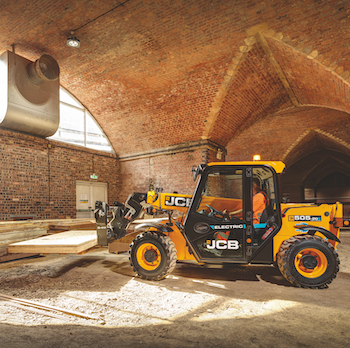 |
| JCB recently introduced an all-electric telehandler, mini excavator and charging station that leverages Li-ion technology. |
Rental centers will find many advantages to electric machines because they offer low maintenance. Maintenance on traditional engines is costly and slows productivity, but with an electric machine, engine maintenance is eliminated. There is no oil filter, fuel filter, water separator, engine oil or air filters to maintain, saving time and money.
Additionally, the rental market will benefit from faster turnaround times from electric machines. The faster you can get a machine to the next customer, the greater your profitability.
There is some operator skepticism about fully electric machines, however, this will quickly change. When operators sit in a JCB E-Tech machine for the first time they are amazed by the machine’s exceptional performance at such low noise levels.
Demand for electric machines at rental centers is already high – a rental fleet that meets this demand will increase profits as well as customer satisfaction. The market is seeing an increase in job applications inside buildings and in areas that need to remain clean and quiet, such as hospitals and office buildings.
There are other considerations for rental centers that offer electric machines. E-Tech rental fleets will need the right charging equipment, just as fuel tanks are necessary to refuel traditional machines, but rental operators will quickly see the ROI is the same. Additionally, rental customers may initially be concerned about machine range or usage time, but JCB’s E-Tech machines have enough charge to last the equivalent of a full day shift. Just as current operators plan to refill fuel based on their fuel gauge, electric machine operators will schedule recharges based on their battery level indicator.
The prospects for electric heavy machinery are exciting in a variety of industry sectors and an attractive option for use near people, animals and crops.
All-electric units solve several customer issues
In recent years, there’s been increasing demand for hybrid and electric machines. With the construction industry typically being a fast follower of the automotive industry, JLG
 |
|
Jennifer Stiansen, JLG Industries, Inc. director of marketing |
engineers are taking cues from the increasing number of electric cars on the road, anticipating a similar increase in demand for electrified heavy equipment in the near future.
Many manufacturers, including JLG, have offered electrified features and battery-powered units for many years. The JLG line of ES series electric-drive scissors for example, are battery powered and have long been considered the industry benchmark for performance due to fewer hydraulics and up to double the battery life vs. standard hydraulic drive models.
JLG’s latest scissor lift introduction, the AE (All Electric) 1932 DaVinci model, is fully electric and the first of its kind. Every component of the machine is optimized, allowing it to be powered with a single Li-ion battery without a compromise to performance. It even recovers energy while the platform is being lowered, which contributes to a 70 percent decrease in power consumption and a longer battery life per charge. Its single Li-ion battery is backed by a class-leading warranty and is expected to last more than 120 months, so owners should never have to replace a battery during the machine’s lifespan.
Customers asked JLG to develop a scissor that minimized leaks and lowered after-the-sale maintenance costs. The AE1932 DaVinci scissor lift doesn’t just contain leaks, it eliminates them altogether. It has zero hydraulics so there are no potential leak points.
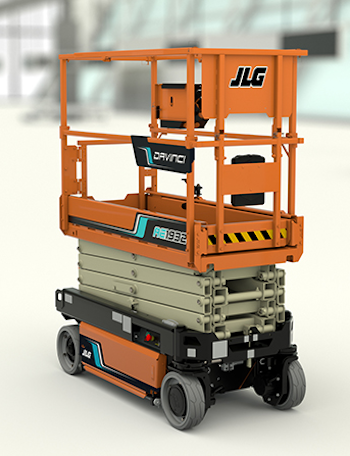 |
| The AE1932 DaVinci offers a 20 percent greater, 600-pound platform capacity indoors and out, travels 2x faster and charges 3.5x faster than a standard lift. |
The AE1932 DaVinci offers a 20 percent greater, 600-pound platform capacity indoors and out, travels 2x faster and charges 3.5x faster than a standard lift. Each wheel is controlled independently to reduce tire wear and limit sensitive floor damage. It is a progressive, environmentally friendly, yet productive solution that eliminates common scissor lift job site challenges.
The rate of adoption for electrified machines is accelerating because the impending Stage 5 engine regulations in Europe will increase the maintenance costs.
At the same time engine costs are increasing, Li-ion battery costs are coming down. Because Li-ion-powered products are greener and less costly, with little to no compromise to performance, they are becoming more popular. JLG experts expect to see less demand for internal combustion (IC) engine-powered models in the future, so it will continue to innovate around electric-powered aerial products that achieve a lower total cost of ownership.
Using the DaVinci scissor as an example, there are no foreseeable downsides. By running only Li-ion power, the major headaches customers report with MEWPs disappear. Failing lead-acid batteries from poor maintenance and charging practices were often the root cause of service calls and costly to replace. Hydraulic leaks were a close second for causing service calls; by removing all hydraulics on the machines, leaks are eliminated altogether.
JLG experts believe the DaVinci technology sets the stage for a new era in scissor lifts. As a manufacturer, JLG will educate the market on this product and its unique features to drive demand to rental centers. Rental companies will look forward to discussing its benefits with customers to build interest and accelerate adoption.
Newer equipment comes with more sophisticated technology. DaVinci engineers strived to take this sophisticated technology and make it simple for the user to operate and maintain.
Cord-free, fume-free
Customers are increasingly wanting to use equipment without cords or fumes. This is allowing users to complete more jobs and in a safer way than in the past.
 |
| Rick Gramoll, M-B-W sales and marketing director |
When rental centers start considering whether to take on next-generation power, they must consider how are these pieces can be fixed if they break down. Just as vehicles have gotten smarter, equipment is following suit and it will likely be harder to work on and in some cases, need to be taken to a specialty shop.
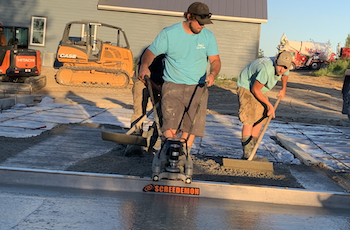 |
| Rental centers can address customers’ needs by adopting battery power equipment earlier in the adoption cycle. Early adopters will be more successful in ROI efforts than those who fight the technology. |
The other thing to consider is the multitude of battery options. Having too many batteries of different brands can cause issues with charging stations and equipment in the field.
The demand for next-generation powered equipment is already here and rental centers can increase their ROI by minimizing the different brands of batteries and maintaining them with proper software and upgrades. Having more tools on one platform will certainly increase ROI.
Today, the most common demand is for smaller handheld tools or items that are going to be used in areas where fumes are not acceptable. As time progresses, batteries will be incorporated on larger and more equipment. Rental centers can address customers’ needs by adopting battery power equipment earlier in the adoption cycle. Early adopters will be more successful in ROI efforts than those who fight the technology.
Rental allows test-driving of new products
Power tools have always been a convenience for users, offering a means to perform tasks more quickly and efficiently when compared with other methods. Recent advances in battery and motor technology have formidably changed the scope of power and durability among corded and cordless power tools.
 |
| Jennifer Hensel, Metabo HPT product manager |
Li-ion batteries have overwhelming advantages over Ni-Cd and other previous battery technologies, while more reliable brushless motors are becoming more affordable to manufacture. The combination of Li-ion batteries and brushless motors have changed the perception of cordless tools, with less maintenance, higher output power and longer runtimes.
Metabo HPT introduced the MultiVolt platform in 2017, combining the above technologies with an extra advantage that makes their platform unique: the MultiVolt AC adapter. All MultiVolt tools on the platform can be powered by 36-volt batteries or can be plugged into AC power with the ET36AM AC adapter. Customers can enjoy the freedom of cordless power when needed or plug into AC power for stationary work on the job site or in the shop. This flexibility in power eliminates the need to purchase cord-free and corded models of the same tool, saving money, space and time in the long run.
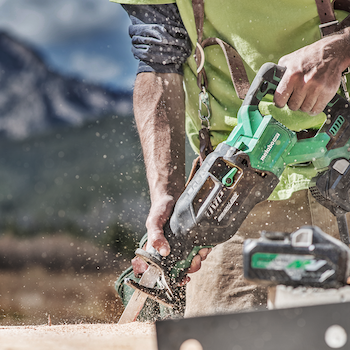 |
| All MultiVolt tools on the Metabo HPT platform can be powered by 36-volt batteries or can be plugged into AC power with the ET36AM AC adapter. Customers can enjoy the freedom of cordless power when needed or plug into AC power for stationary work on the job site or in the shop. |
Rental centers can take advantage of the latest technology in power tools by including some of these tools in their product offering. Brushless motors eliminate the need for carbon brush replacement, which is the No. 1 cause for maintenance and downtime for brushed power tools. Having more capable 18- and 36-volt tools is appealing to the end user, offering more power and longer run times to get the job done faster.
These advances come with a price tag, which is a concern when considering adding them to a rental fleet. Tools with less maintenance and better performance than their predecessors will result in time and money saved on the job site and ultimately result in more satisfied customers.
Rental programs are a way for users to experience the full benefits of the latest and greatest tools without the financial impact of a full purchase. Adding the latest tools to a rental is an investment that pays out in the long run. Rental centers can increase demand for the latest and greatest tools by working with manufacturers to take advantage of promotions, discounts and other incentive to get these tools in the users’ hands.
It is imperative to have a strong, reliable contact from the manufacturer. As with all tools and equipment, there are inevitable repairs and maintenance. If the tool cannot be serviced on site or at the rental center, most tool producers offer quick and reliable ways to get the tool back to work with minimal down time.
The time and labor costs saved from advanced product lines can easily change the opinions of users, leading to better returns on investment, repeat business, and additional accessory sales for rental centers.
Battery power opens new opportunities
Li-ion battery-powered outdoor equipment is quickly becoming just as powerful and more efficient than their gas-powered cousins. This makes for some interesting times for
 |
|
JJ Harris, MiniTrencher general manager |
manufacturers and consumers alike. The industry is on the cusp of a paradigm shift in the green industry. Chainsaws, string trimmers and even lawnmowers have gone battery-powered very successfully and in the trenching community it is only been a matter of time.
GeoRipper recently released its first prototype battery-powered handheld trencher, the PowerCutter. It is the first full-size, battery-powered mini trencher on the market. As other name-brand competitors in the concrete cutting industry bring out cordless battery-powered saws, MiniTrencher will be working to bring an entire line of zero-emission trenchers that will open a new segment for mini-trencher products: crawlspace and basement drainage abatement.
The GeoRipper battery-powered mini trenchers will be able to easily go under houses and into basements for whatever trenching is needed. Less noise and zero emissions mean that the operator will not be worried about noxious fumes, and the noise reduction at idle will allow the operator to work with less noise and potential harm.
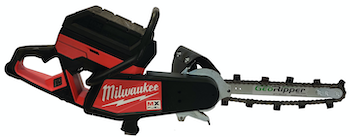 |
|
MiniTrencher will be working to bring an entire line of zero-emission trenchers that will open a new segment for MiniTrencher products: crawlspace and basement drainage abatement. |
Rental centers need to keep their customers’ expectations realistic when renting ground-breaking, battery-powered machinery. Battery technology has improved exponentially over the last few years, but it also still has a long way to go for the ease of use of a gas-powered equivalent. Charging batteries is the most frustrating issue when switching over to next-generation power. For trenching machinery like GeoRipper, the battery life is still shorter than the time it takes to charge the battery.
To obtain highest ROI, don’t under-rent the product. As cutting-edge technology becomes available, it comes at a premium price. The environment-focused customer is accustomed to paying a higher rate for green technology, especially while it is still in its early stages. Rental centers should not be apologetic that the battery-powered equivalent is more expensive to rent than the traditional, gas-powered model.
Rental centers will need to develop a maintenance and disposal plan for Li-ion batteries as they get older. The biggest issue with the current line of next-generation products is the battery. Although they are much more sustainable and long-lasting than their earlier counterparts, the battery still contains heavy metals and toxic chemicals that can be dangerous in high quantities in landfills. Proper recycling and disposal of these products will allow rental centers to fully realize the environmentally friendly approach these tools offer.
Propane offers advantages
Advances in alternative energy sources, including propane, are being made to address one common trend: sustainability. The construction industry has a significant impact on the environment and the equipment we use is responsible for greenhouse gas and other pollutants.
 |
| Matt McDonald, Propane Education & Research Council (PERC) director of off-road business development |
Some have adopted an “electrify everything” mindset, but that movement can be misleading because of the upstream emissions produced in the creation and transmission of electricity and the manufacturing of batteries.
For the businesses seeking a better emissions profile for their equipment, propane can provide a clean energy alternative. Propane is an approved clean energy source under the Clean Air Act of 1990 and won’t contaminate air, water or soil resources.
Additionally, propane equipment reduces harmful emissions when compared with equipment powered by gasoline, diesel and even battery-power. Notably, propane-powered small-engine applications can reduce carbon monoxide emissions by up to 50 percent when compared with gasoline models, according to PERC data. Further, propane equipment reduces greenhouse gas emissions by up to 17 percent and sulfur oxide (SOx) emissions by up to 16 percent when compared with gasoline.
Propane’s versatility extends to a wide variety of light construction equipment, including power generators, which is a growing consumer need.
With the push toward zero emissions, rental centers are likely bringing in more battery-powered equipment, but there are a few key challenges unique to electric equipment for customers to consider. One challenge is that some batteries require frequent cleaning to help avoid chemical buildup. The Environmental Protection Agency (EPA) considers commercial batteries a hazardous material, which means businesses can’t simply dispose of them when the batteries go dead. They have specific handling and disposal regulations.
Crews operating propane equipment can avoid chemical spills from lead-acid battery-powered equipment, hazardous spills from diesel-fueled equipment and electrical hazards from chargers.
The industry has seen a recent trend of brands moving away from corded equipment on job sites. Brands that once offered electric-only equipment have started to offer engine-driven solutions, mostly powered by propane.
Another perk of propane for rental customers is its availability and convenience, especially on sites that aren’t yet connected to utilities.
Rental centers can increase ROI by making their business a one-stop shop for customers where they can rent the equipment and purchase the fuel.
Businesses are on the lookout for technologies and equipment that offer the most carbon reduction impact for their investment. Addressing those needs by offering a clean, low-emissions fuel and educating rental customers about their options has become increasingly important; that trend will continue.
Rental centers that are well-versed in the types of clean alternative fuels will set themselves up for success. They will be equipped to get customers familiar with the benefits of different alternative fuels, what kind of equipment they can power, and which might be the best fit for a customer’s specific operation.
Commercial quality wins over contractors
Over the past few years, the battery-powered outdoor power equipment (OPE) market has grown significantly and will at least match the gasoline market in the not-too-distant future. In fact, Stihl battery sales to dealers were up double digits in 2020.
 |
|
Mike Poluka, Stihl product manager |
Battery technology has improved vastly, providing users a powerful alternative to gasoline-powered equipment while offering a host of benefits including ease of use, zero exhaust emissions, reduced noise, no fuel costs and reduced maintenance.
Stihl research and development teams continue to make advances to deliver battery technology performance comparable to that of gasoline-powered equipment.
Launching in 2021, the Stihl 135 battery platform is packed with Stihl quality and durability, delivering true commercial-grade power and performance comparable to gasoline-powered tools, all with zero exhaust emissions and low noise. All products feature an on-board battery slot and weather-resistant design that allow professional users to keep working with less downtime.
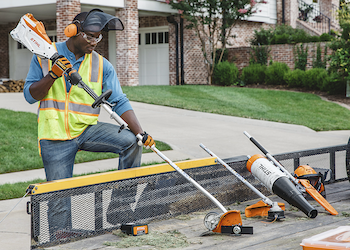 |
| The Stihl 135 battery platform includes a KombiMotor multi-task tool, a pole pruner, string trimmers and extended-reach hedge trimmers. They use the same shaft and cutting components found on Stihl gasoline-powered units. |
The 135 battery platform is assembled in America and includes a KombiMotor multi-task tool, a pole pruner, string trimmers and extended-reach hedge trimmers. They use the same shaft and cutting components found on Stihl gasoline-powered units.
There are many positive aspects of adding battery-powered equipment into a rental fleet. Battery-powered products are incredibly low maintenance, which reduces the overhead and maintenance costs. All Stihl battery products feature a brushless electric motor for optimal performance and durability with little to no maintenance required.
Battery-powered equipment is easy to use, easy to start and offers performance levels comparable to gas-powered equipment. Rental customers, especially homeowners, may not be familiar with proper starting procedures on gas-powered equipment. They may be unaware of the need for the proper fuel/mix, choke vs. run position, ignition switch or what to do if the equipment becomes flooded. This can significantly reduce productivity and increase customer dissatisfaction.
It’s important to recommend renting battery-powered equipment with a sufficient number of batteries and chargers depending on the equipment rented. As one battery is in use, the other batteries can be charging, limiting unnecessary downtime.
To increase demand, rental centers should educate their teams on the benefits of battery products, who in turn, communicate those benefits to customers. For homeowner customers, promoting the ease of use – no fuel to mix, no cords, easy starting and operation; and environmental benefits – zero exhaust emissions, low noise – may be appealing points.
For professional contractors, promoting the ease of use, commercial-grade performance and emphasizing how low noise and zero exhaust emissions can extend their working hours can appeal to them.
When customers rent equipment, they’re running on a timer. They do not have time to experience any unexpected issues, so productivity truly matters. As long as the equipment offers performance levels similar to gas-powered equipment, the ease of battery-powered equipment can greatly increase productivity.
Gain access to inside jobs
Li-ion battery technology has evolved to a point where the energy density and cost make it accessible to the construction industry. Costs of Li-ion technology have dropped 90 percent in the past 10 years, according to business e-newsletter, Bloomberg Green.
 |
| Jay Thaker, Toro Sitework Systems rental marketing manager |
The safety that comes along with battery technology is a trend that is likely here to stay. Battery-operated equipment greatly reduces or eliminates exhaust emissions and minimizes noise pollution.
The Toro e-Dingo 500 is a prime example of customers accomplishing everything they need to with battery power without sacrificing performance. Battery-driven units deliver power comparable to gas and diesel machines, can potentially help reduce operating costs regarding fuel and maintenance and can usually achieve a full charge in less than eight hours.
Li-ion power expands the use of power equipment on job sites where it couldn’t traditionally be used, such as interior spaces. Li-ion power also eliminates the need to store back-up fuel on the job site.
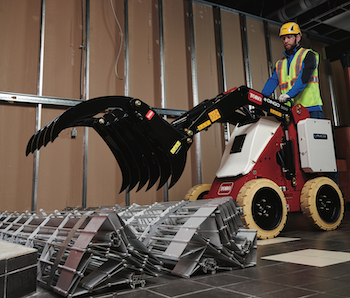 |
| Battery-driven units deliver power comparable to gas and diesel machines, can potentially help cut down on operating costs regarding fuel and maintenance, and can usually achieve a full charge in less than eight hours. |
If customers tend to be more traditional, it might be harder to persuade them to make a change. Rental store sales personnel can focus on selling the benefits – fewer emissions and a quieter jobsite – and the decision to rent will follow.
Companies are looking for electric equipment in the construction industry to help them complete jobs that would have otherwise required additional labor and cost. That’s where rental centers can fill a need. They can solve that problem, becoming the local go-to source for Li-ion powered equipment.
In some cases, battery power may not be comparable to the power standards customers are used to with gas-powered machines. In that case, rental store staff will need to work with customers to find other areas in their operation that would benefit from Li-ion technology.
Charging time may also be another objection. For most projects, users can use the unit during the day and charge it when not in use or overnight. If the project is more intensive or active at all hours of the day, consider renting multiple units.
Four trends driving Li-ion power
Four major trends are driving the shift toward electromobility or electrification. The most obvious is the push toward sustainability, because electric vehicles significantly reduce machine emissions.
 |
| Ray Gallant,Volvo Construction Equipment vice president of product management and productivity |
The second primary driver is political change. Over the past decade, government programs and incentives have been created to promote sustainability. Fifteen states and the District of Columbia have committed to being 100 percent emission-free by 2050.
The third trend is urbanization. In 1950, the United Nations estimated that 30 percent of the population was urban-based, and 70 percent was agrarian. Today, it has basically reversed.
The final trend is technology. As electrification and automation technologies develop, efficient, workable machines can be built that could not have been built just 10 years ago. That innovation opens new opportunities and ways of using equipment.
In Volvo and other testing, the total cost of ownership (TCO) on electric machines is superior in the long-term to diesel machines because electric machines have fewer moving parts, fewer fluids and lubrication requirements and reduced energy costs. Connective technologies can monitor the function of these machines very closely to identify any issues before downtime occurs. The more these new technologies are developed, the lower the cost of ownership will go. Rental centers may also have revenue opportunities to provide rapid charging, or even provide charging infrastructure for their rental customer’s sites.
 |
| In Volvo and other testing, the total cost of ownership (TCO) on electric machines is superior in the long-term to diesel machines because electric machines have fewer moving parts, fewer fluids and lubrication requirements and reduced energy costs. |
Rental centers are unique because they can offer their customers a chance to try these new technologies without having to buy it. That is something they should promote, which should help them increase demand and ROI.
Another tip is to share information with your customers about sustainability trends and developments. More of their clients or projects will include sustainability requirements as this movement grows.
Another benefit to emphasize is how quiet electric machines are, making them excellent for overnight work or projects near offices and homes where they want to keep disturbances to a minimum.
First-time users will also be impressed by the electric machines’ very comparable capabilities to diesel machines. The unique features in an electric machine will help rental centers meet the unique needs that diesel machines cannot provide and help maintain premium rental rates.
To realize most success with next-generation power, a charging infrastructure needs to grow. Rental centers can create value for their renters by installing charging stations at their centers (ideal for short rentals) or renting charging stations to their customers who need fast charging over extended periods.
Volvo is developing electric machines that ease these issues. The Volvo ECR25 electric mini-excavator and L25 electric compact wheel loader are fitted with Li-ion batteries that allow for up to eight hours of operation in typical applications. Both machines have onboard chargers that enable overnight charging using conventional household electrical systems. However, an off-board fast charger to charge both machines requires three-phase power.
Even if customers want to do the right thing for the environment, they probably don’t want to sacrifice performance. Rental centers can address this by buying and renting electric machines that offer the equivalent productivity and unique features to meet their customers’ needs. Volvo electric machines have performance levels similar to their diesel equivalents. For example, the ECR25 electric mini excavator has a digging depth of 9 feet and a breakout force of 4,541 foot-pounds. The L25 electric front-end loader has a full-turn tipping load of 3.7 tons, a dump height of 8.2 feet, and a 2.2-ton payload fork load capacity.
The future is powered by batteries
As civilization races full speed into the future of technology, the batteries that power that technology must do the same. The only thing limiting technology advancement is the power source itself. Despite significant improvements in batteries over the past 20 years, plenty of room exists for innovation in energy density, safety, cost, life and stability.
 |
|
Alex Berg, Cratos Equipment founder |
We are approaching a power revolution. As incredible as Li-ion batteries are, more power density from them is possible. Getting more power in them in less time is a milestone that will soon be met. Small changes, such as replacing the anode in batteries and using silicon in lithium batteries, could yield 10 times present capacity. That is just one of the many advances that are presently underway.
This battery innovation is critical because customers are demanding battery-powered equipment at startling rates. It opens up a world of possibilities, increasing safety, profitability and efficiency while reducing construction’s environmental impact.
For rental houses, even smaller operations, the best part is that there is not much downside risk toward Li-ion battery-powered machines. The downside is limited to the initial cost, which is easily overcome when factoring in long-term maintenance and repair savings. While more expensive, a Li-ion battery can be recharged thousands of times and used for thousands of hours with almost zero maintenance. With higher energy density and cells having longer charge retention, purchasing electric equipment with a Li-ion battery is the best investment. A diesel engine has hundreds of moving parts, while the electric motor has very few parts. Fewer parts mean less maintenance and repairs and thousands of dollars saved. This is a win for smaller rental centers because they have a machine that will last a very long time without the long-term maintenance costs.
Electric construction machines are already in high demand. In the next 20 years, backhoes, excavators, dozers, graders and other heavy equipment will be all-electric. With stricter emissions standards and the advances in technology, rental centers with a dedicated electric fleet should have no problems increasing the demand for their battery-powered equipment.
Rental centers can do their part to build greater demand by consistently providing information to existing customers who may require LEED certification or ways to work in quiet zones. Customers need to know that electric machines are available, have all-day battery life, or bring the same performance as their diesel counterparts.
People are all about perception. They may perceive that a quiet car isn’t fast and the same holds with construction equipment. If the machinery is silent, it isn’t as powerful. Today, performance doesn’t have to be loud and it doesn’t have to be inconvenient, which is another misconception customers may have. At Cratos Equipment simply charge with a standard 110-volt outlet. If a job site doesn’t have power, a battery bank can recharge the machine after a full workday. Batteries will power the future, and Cratos is excited to be a part of it.
----------------
This story originally appeared in the January-February 2021 issue of Pro Contractor Rentals magazine, ©2021 Urbain Communications LLC. All rights reserved.



